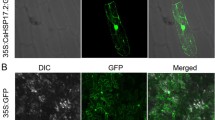Abstract.
Small heat-stress proteins (sHsps) are the most abundant stress-induced proteins with up to 20 different members in higher plants. In the cytoplasm, two different classes can be distinguished. Two cDNA clones from tomato Lycopersicon peruvianum (L.) Mill., each coding for one of the cytoplasmic sHsp subfamilies, were analyzed with respect to their transcript and protein expression, genome organization and chaperone activity. Neither type was present under control conditions but both appeared upon heat stress and in mature fruits. Expression of the class II transcript was found to be induced at slightly lower temperatures than the class I transcript. Protein analysis using class-specific antibodies revealed an identical expression pattern of both corresponding proteins. Transient expression in an Arabidopsis thaliana (L.) Heynh. cell culture showed that, despite the difference in their amino acid sequence, both classes are functionally active as chaperones in vivo, as shown by their ability to prevent thermal inactivation of firefly luciferase in a cellular environment.
Similar content being viewed by others
Author information
Authors and Affiliations
Additional information
Received: 24 November 1999 / Accepted: 14 March 2000
Rights and permissions
About this article
Cite this article
Löw, D., Brändle, K., Nover, L. et al. Cytosolic heat-stress proteins Hsp17.7 class I and Hsp17.3 class II of tomato act as molecular chaperones in vivo. Planta 211, 575–582 (2000). https://doi.org/10.1007/s004250000315
Issue Date:
DOI: https://doi.org/10.1007/s004250000315




